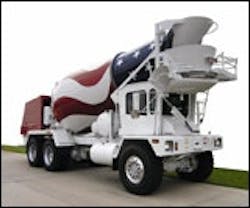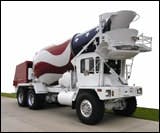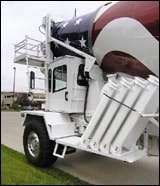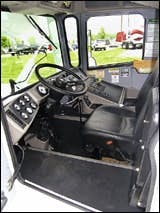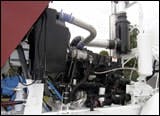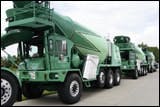Terex Mixer Shows Concept's Advantages
Front-discharge concrete mixers have been around for more than 40 years, but they're not used in many markets so they might seem foreign to many folks in the construction business. They are very American, though, and lend speed and productivity that contractors and workers appreciate.
A long time ago I was one of them. In 1976, while between writing jobs, I worked as a laborer for a small contractor in northern Wisconsin. I recall odd-looking trucks with small center cabs showing up on some pouring jobs, and was impressed at how fast they off-loaded. I didn't like having to run with the wheelbarrow to keep up with them (one of the pours was too big and access too limited for the trucks' chutes to reach at first), but I admired their speed.
Only recently did I learn some of their history. In 1964, R.W. Sims, a concrete producer in Salt Lake City, Utah, invented the front-discharge, rear-engine concept and began making trucks in an operation that eventually became Savage (and later died under Mack ownership). Sims granted a manufacturing license to Jim and "Skunk" Irving, who ran a ready mix outfit in Fort Wayne, Ind. They began building the squat but nimble trucks for their own use, then for others. This company was called Riteway (the name of the mixers I saw), according to Dan Biberstine, who began working there in 1968 and now heads a competitor, Indiana Phoenix.
Riteway — meaning this is the way concrete should be delivered, in the Irvings' opinion — went through good times and bad, Biberstine related. It expanded, was sold to a company in Texas, went bankrupt, then reemerged in 1972 in Fort Wayne as Advance Mixer. Around the turn of the century there was another ownership change and bankruptcy and, in 2002, Advance was acquired by Terex Roadbuilding, the machinery maker based in Oklahoma City.
The new parent changed the product's name to Terex, and has provided valuable financial, marketing and engineering resources, said Ted Deckard, director of plant operations in Fort Wayne. Terex Advance has branched into building and installing rear-discharge mixer bodies on conventional chassis of various makes. It now employs 280 people and produces six trucks a day, four of which are the front-discharge type.
Deckard showed me the factory, where pneumatic wrenches whine and welding torches flash constantly, then walked me out to a lot full of new trucks awaiting shipment. There I picked out the one you see here. It is Terex's basic model, called FD3000 (for front-discharge, three-axle), which sports a Stars & Stripes paint scheme that he said is popular with customers.
"It's an easy truck to drive," he commented, and it certainly was, once I figured out the best way to ease my body (which has grown in poundage and girth since my laboring days) into the low-slung cab. Once seated, I admired the excellent visibility in all directions except to the very rear and, of course, well-placed mirrors took care of that.
On the three-section instrument panel, gauges are to the driver's front and left, and most controls are to the right. It's all well laid out and easy to use. Power windows are among the standard features of the Wide Workspace cab, and this one had air conditioning as well.
The cab is wide enough for a second seat, a fold-up type just to the driver's left. This allows a driver-trainer to ride along and give instructions to a new guy, and closely watch what he's doing. With the previous narrow cab, one or the other had to get to the jobsite in a separate vehicle, and the trainer then perched on the platform next to the window to shout instructions. Advance offered a two-man cab for training, but now all of its trucks go out with the 68-inch-wide cab.
The Cummins ISM diesel sits about 25 feet behind the cab, under a fiberglass hood that hangs behind the tandem, so its sounds were distant. Terex also offers Caterpillar's C11 and C13 and Cummins' lightweight ISL. But the ISM, set at 350 or 385 horsepower, is the most popular engine because it costs less than the Cats and has more torque than the midrange-size ISL, Deckard said.
I cranked over the engine, waited for it to settle into an idle, released the parking brake and punched D for Drive in the Allison automatic transmission. I headed out the gate and onto nearby county and township roads. Terex workers test each truck and mixer body with a load of crushed limestone, but this one had already been through that and its drum was empty.
Thus, the truck accelerated quickly and bounded along with ease. Its tandem sat on a stiff rubber-block suspension, so the truck bounced a lot on old, bowed concrete — ironic, given its mission of delivering that material, I thought — but was smooth over asphalt — another irony. I'm guessing that multi-axle configurations ride better, and even this one would be fine while under load. Besides, two air-ride suspensions are optional.
Sitting in the center of the chassis took a minute or two to get used to. It was an easy transition from a conventional truck with its left-hand drive, though, maybe because the chute just outside the windshield, and the funnel and other equipment above that, seemed to make the center seating appropriate. It certainly would be during a pour, though, of course, I didn't do that on this day.
Good visibility, decent maneuverability and the Allison automatic make the truck easy to drive, but are also important to its delivery role. If you've seen one of these working, you know that a front-discharge mixer drives right up to a pour site and quickly begins off-loading. The driver gets out to attach extensions to the chute, then returns to the cab to control the hydraulically powered chute and drum.
With a control lever, he raises and lowers the chute and swings it left or right, while moving the truck fore and aft to keep the end of the chute properly positioned. He speeds and slows the drum with a foot pedal next to the steering column. A manual transmission with its clutch pedal and shift lever would add considerable clumsiness to the operation, so the Allison is a key component. External controls, either mechanical or electronic, with a hand-held remote, allow someone on the crew to run the chute if he wants to, and the driver uses them to wash out the chute and funnel.
Driver operation of the chute means the contractor can eliminate one man from his crew. That and the speed of the pour save him money, and he and other contractors begin demanding that their concrete be delivered this way. So when one ready mix operator begins buying these trucks, he gains an advantage and competitors generally follow suit. This is why front-discharge mixers became popular in certain markets, mostly in the Midwest, Northeast and Florida (and, of course, Salt Lake City), but not in most others, where producers have thus far avoided them.
Partly because of the Allison, a front-discharge mixer costs more than a conventional mixer truck. But that's made up by productivity, proponents say. Because a front-discharge mixer unloads fast, it can usually haul one extra load in a work shift, boosting revenue and helping to pay off its purchase premium.
Anyway, it took me almost 30 years to move from wheelbarrow to the driver's seat of this truck. Like the guy who's been poor and rich but prefers rich, I like driving better, especially in a fast and nimble truck like this.
